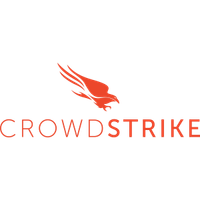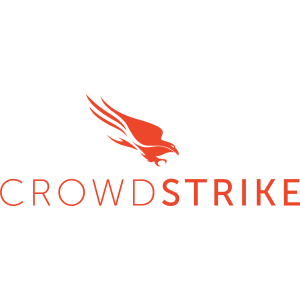
CrowdStrike Holdings Inc
NASDAQ:CRWD


| US |

|
Johnson & Johnson
NYSE:JNJ
|
Pharmaceuticals
|
| US |

|
Berkshire Hathaway Inc
NYSE:BRK.A
|
Financial Services
|
| US |

|
Bank of America Corp
NYSE:BAC
|
Banking
|
| US |

|
Mastercard Inc
NYSE:MA
|
Technology
|
| US |

|
UnitedHealth Group Inc
NYSE:UNH
|
Health Care
|
| US |

|
Exxon Mobil Corp
NYSE:XOM
|
Energy
|
| US |

|
Pfizer Inc
NYSE:PFE
|
Pharmaceuticals
|
| US |

|
Palantir Technologies Inc
NYSE:PLTR
|
Technology
|
| US |

|
Nike Inc
NYSE:NKE
|
Textiles, Apparel & Luxury Goods
|
| US |

|
Visa Inc
NYSE:V
|
Technology
|
| CN |

|
Alibaba Group Holding Ltd
NYSE:BABA
|
Retail
|
| US |

|
JPMorgan Chase & Co
NYSE:JPM
|
Banking
|
| US |

|
Coca-Cola Co
NYSE:KO
|
Beverages
|
| US |

|
Walmart Inc
NYSE:WMT
|
Retail
|
| US |

|
Verizon Communications Inc
NYSE:VZ
|
Telecommunication
|
| US |

|
Chevron Corp
NYSE:CVX
|
Energy
|
Utilize notes to systematically review your investment decisions. By reflecting on past outcomes, you can discern effective strategies and identify those that underperformed. This continuous feedback loop enables you to adapt and refine your approach, optimizing for future success.
Each note serves as a learning point, offering insights into your decision-making processes. Over time, you'll accumulate a personalized database of knowledge, enhancing your ability to make informed decisions quickly and effectively.
With a comprehensive record of your investment history at your fingertips, you can compare current opportunities against past experiences. This not only bolsters your confidence but also ensures that each decision is grounded in a well-documented rationale.
Do you really want to delete this note?
This action cannot be undone.

| 52 Week Range |
308.86
557.53
|
| Price Target |
|
We'll email you a reminder when the closing price reaches USD.
Choose the stock you wish to monitor with a price alert.

|
Johnson & Johnson
NYSE:JNJ
|
US |

|
Berkshire Hathaway Inc
NYSE:BRK.A
|
US |

|
Bank of America Corp
NYSE:BAC
|
US |

|
Mastercard Inc
NYSE:MA
|
US |

|
UnitedHealth Group Inc
NYSE:UNH
|
US |

|
Exxon Mobil Corp
NYSE:XOM
|
US |

|
Pfizer Inc
NYSE:PFE
|
US |

|
Palantir Technologies Inc
NYSE:PLTR
|
US |

|
Nike Inc
NYSE:NKE
|
US |

|
Visa Inc
NYSE:V
|
US |

|
Alibaba Group Holding Ltd
NYSE:BABA
|
CN |

|
JPMorgan Chase & Co
NYSE:JPM
|
US |

|
Coca-Cola Co
NYSE:KO
|
US |

|
Walmart Inc
NYSE:WMT
|
US |

|
Verizon Communications Inc
NYSE:VZ
|
US |

|
Chevron Corp
NYSE:CVX
|
US |
This alert will be permanently deleted.
CrowdStrike Holdings Inc



In the bustling realm of cybersecurity, where threats lurk in the shadows of digital networks, CrowdStrike Holdings Inc. stands as a formidable sentinel. Founded in 2011, this company emerged with a vision to provide cutting-edge protection against cyber adversaries. Operating on a cloud-based platform, CrowdStrike enhances its capabilities using artificial intelligence and machine learning, setting it apart in the crowded cybersecurity landscape. At the heart of its operation lies the Falcon platform, a sophisticated tool that integrates endpoint protection, threat intelligence, and incident response into a seamless service. This cloud-native approach allows CrowdStrike to detect and respond to threats with unprecedented speed and precision, safeguarding its clients from ever-evolving cyber risks.
CrowdStrike generates revenue primarily through a subscription model, offering its Falcon platform to a wide range of industries—from financial services to healthcare. The company's success heavily relies on its ability to scale its cloud architecture, ensuring high-speed data processing and real-time analytics across vast digital environments. Each client agreement typically involves a multi-year contract, securing steady financial inflows and reinforcing customer reliance on its comprehensive suite of services. The financial health of CrowdStrike benefits not only from these sustained customer engagements but also from the added value of its threat intelligence offerings, which provide clients with actionable insights into potential and existing threats. Balancing innovation and operational efficiency, CrowdStrike remains a pivotal figure in the cybersecurity space, navigating the complexities of online security in an increasingly interconnected world.

In the bustling realm of cybersecurity, where threats lurk in the shadows of digital networks, CrowdStrike Holdings Inc. stands as a formidable sentinel. Founded in 2011, this company emerged with a vision to provide cutting-edge protection against cyber adversaries. Operating on a cloud-based platform, CrowdStrike enhances its capabilities using artificial intelligence and machine learning, setting it apart in the crowded cybersecurity landscape. At the heart of its operation lies the Falcon platform, a sophisticated tool that integrates endpoint protection, threat intelligence, and incident response into a seamless service. This cloud-native approach allows CrowdStrike to detect and respond to threats with unprecedented speed and precision, safeguarding its clients from ever-evolving cyber risks.
CrowdStrike generates revenue primarily through a subscription model, offering its Falcon platform to a wide range of industries—from financial services to healthcare. The company's success heavily relies on its ability to scale its cloud architecture, ensuring high-speed data processing and real-time analytics across vast digital environments. Each client agreement typically involves a multi-year contract, securing steady financial inflows and reinforcing customer reliance on its comprehensive suite of services. The financial health of CrowdStrike benefits not only from these sustained customer engagements but also from the added value of its threat intelligence offerings, which provide clients with actionable insights into potential and existing threats. Balancing innovation and operational efficiency, CrowdStrike remains a pivotal figure in the cybersecurity space, navigating the complexities of online security in an increasingly interconnected world.
Record Quarter: CrowdStrike reported its best quarter ever, with accelerated growth across all major business lines and record financial results.
ARR Acceleration: Net new Annual Recurring Revenue (ARR) hit a record $265 million, up 73% year-over-year, and total ARR reached $4.92 billion, up 23%.
Revenue Beat & Raised Guidance: Q3 revenue was $1.23 billion, up 22% YoY, exceeding guidance. Full-year revenue guidance was raised to $4.797–$4.807 billion.
Profitability: Operating income reached a record $264.6 million (21% margin), with free cash flow also at a record $295.9 million (24% margin).
Product Momentum: Strong growth in Next-Gen SIEM, Identity, Cloud, and Endpoint security, with the Falcon Flex subscription model driving higher adoption and module attach rates.
AWS Partnership: CrowdStrike’s Falcon Next-Gen SIEM will be offered natively to AWS’s millions of customers, boosting expansion opportunities.
AI Demand: Management emphasized AI as a key market driver, both as a source of risk and opportunity, with CrowdStrike positioning itself as essential for secure AI adoption.
Guidance: FY '27 net new ARR growth of at least 20% reaffirmed, with strong confidence in continued profitable growth.
Management

George R. Kurtz is the co-founder and CEO of CrowdStrike Holdings, Inc., a leading cybersecurity company specializing in digital threat protection and intelligence. Kurtz co-founded CrowdStrike in 2011 with the aim of transforming cybersecurity with a cloud-delivered endpoint protection platform. Under his leadership, CrowdStrike has grown rapidly, gaining a reputation for its innovative approach to cybersecurity and its ability to detect and prevent complex cyber threats. Before founding CrowdStrike, Kurtz held significant roles in other prominent technology and cybersecurity companies. He served as the Worldwide Chief Technology Officer and Executive VP at McAfee, where he was instrumental in developing new products and enhancing the company's cybersecurity suite. Prior to McAfee, he was the CEO and co-founder of Foundstone, a security consulting firm that was later acquired by McAfee in 2004. Kurtz is well-regarded in the cybersecurity industry for his expertise and thought leadership. He is often seen speaking and writing about cybersecurity challenges and innovations. Additionally, he is credited with authoring several books on cybersecurity, reflecting his depth of knowledge in the field. Kurtz's vision with CrowdStrike has been to leverage cloud computing and AI to improve threat detection and response times, offering businesses a more agile and effective cybersecurity solution. His strategic direction and management have positioned CrowdStrike as a major player in the cybersecurity market.

Before founding CrowdStrike, Kurtz held significant roles in other prominent technology and cybersecurity companies. He served as the Worldwide Chief Technology Officer and Executive VP at McAfee, where he was instrumental in developing new products and enhancing the company's cybersecurity suite. Prior to McAfee, he was the CEO and co-founder of Foundstone, a security consulting firm that was later acquired by McAfee in 2004.
Kurtz is well-regarded in the cybersecurity industry for his expertise and thought leadership. He is often seen speaking and writing about cybersecurity challenges and innovations. Additionally, he is credited with authoring several books on cybersecurity, reflecting his depth of knowledge in the field.
Kurtz's vision with CrowdStrike has been to leverage cloud computing and AI to improve threat detection and response times, offering businesses a more agile and effective cybersecurity solution. His strategic direction and management have positioned CrowdStrike as a major player in the cybersecurity market.

Michael Sentonas is the President of CrowdStrike Holdings Inc., a leading cybersecurity technology company. He has played an instrumental role in advancing CrowdStrike's technological innovations and strategic direction. Before becoming President, Sentonas served as the Chief Technology Officer (CTO) at CrowdStrike, where he focused on overseeing the technology strategy and driving product vision and innovation. He brings with him extensive experience in the cybersecurity industry, having worked in various leadership roles prior to joining CrowdStrike. Sentonas is known for his deep expertise in cybersecurity technology and his ability to interpret and anticipate industry trends, which has been invaluable in steering CrowdStrike's rapid growth and maintaining its position as an industry leader. His leadership and vision have helped the company expand its solutions, improve threat detection and response capabilities, and strengthen its overall cybersecurity platform. Sentonas is recognized for his thought leadership in the cybersecurity space, often speaking on topics related to cyber threats, protection strategies, and the future of cybersecurity technology.

He brings with him extensive experience in the cybersecurity industry, having worked in various leadership roles prior to joining CrowdStrike. Sentonas is known for his deep expertise in cybersecurity technology and his ability to interpret and anticipate industry trends, which has been invaluable in steering CrowdStrike's rapid growth and maintaining its position as an industry leader.
His leadership and vision have helped the company expand its solutions, improve threat detection and response capabilities, and strengthen its overall cybersecurity platform. Sentonas is recognized for his thought leadership in the cybersecurity space, often speaking on topics related to cyber threats, protection strategies, and the future of cybersecurity technology.

Burt W. Podbere is the Chief Financial Officer (CFO) of CrowdStrike Holdings Inc., a leading cybersecurity company. Podbere joined CrowdStrike in 2015, bringing a wealth of experience in financial management and strategic planning. As CFO, he is responsible for overseeing the company’s financial operations, including accounting, finance, investor relations, and strategic planning. Before joining CrowdStrike, Podbere held significant roles across various technology companies. Notably, he served as the CFO of OpenDNS, where he played a crucial role in the company's successful sale to Cisco Systems. Podbere also worked as CFO at Net Optics, where he was instrumental in overseeing the company’s acquisition by Ixia. His career includes important financial leadership roles at other technology companies, contributing to IPOs, mergers, and acquisitions. Podbere's expertise lies in scaling fast-growing companies, managing financial strategy during rapid expansion, and driving operational efficiency. He is a Certified Public Accountant (CPA), which adds to his strong foundation in finance and accounting. Through his leadership at CrowdStrike, Podbere has been pivotal in guiding the company through its public offering and subsequent growth, solidifying its position in the cybersecurity industry.

Before joining CrowdStrike, Podbere held significant roles across various technology companies. Notably, he served as the CFO of OpenDNS, where he played a crucial role in the company's successful sale to Cisco Systems. Podbere also worked as CFO at Net Optics, where he was instrumental in overseeing the company’s acquisition by Ixia. His career includes important financial leadership roles at other technology companies, contributing to IPOs, mergers, and acquisitions.
Podbere's expertise lies in scaling fast-growing companies, managing financial strategy during rapid expansion, and driving operational efficiency. He is a Certified Public Accountant (CPA), which adds to his strong foundation in finance and accounting. Through his leadership at CrowdStrike, Podbere has been pivotal in guiding the company through its public offering and subsequent growth, solidifying its position in the cybersecurity industry.
Shawn Henry is a key executive at CrowdStrike Holdings Inc., a renowned cybersecurity technology company. Before joining CrowdStrike, Henry had a distinguished career in the Federal Bureau of Investigation (FBI). He served as the FBI's Executive Assistant Director, overseeing cybercrime investigations and operations. His extensive experience in cybersecurity and investigative work made him an ideal fit for a leadership position in the private sector at CrowdStrike. At CrowdStrike, Shawn Henry is often involved in strategic operations and provides insights into threat intelligence, leveraging his law enforcement background to help guide the company's approach to tackling cyber threats. He is widely respected for his expertise in cybersecurity and his ability to address complex security challenges that businesses face. His leadership plays a crucial role in CrowdStrike's mission to provide advanced cybersecurity solutions to protect organizations worldwide.
At CrowdStrike, Shawn Henry is often involved in strategic operations and provides insights into threat intelligence, leveraging his law enforcement background to help guide the company's approach to tackling cyber threats. He is widely respected for his expertise in cybersecurity and his ability to address complex security challenges that businesses face. His leadership plays a crucial role in CrowdStrike's mission to provide advanced cybersecurity solutions to protect organizations worldwide.
Dmitri Alperovitch is a prominent cybersecurity expert and businessman known for co-founding CrowdStrike Holdings Inc., a leading cybersecurity firm. Alperovitch was born in Moscow, Russia, and later moved to the United States, where he pursued higher education and built his career in cybersecurity. He holds a B.S. in Computer Science and a M.S. in Information Security from the Georgia Institute of Technology. Alperovitch's experience in cybersecurity began with roles in various tech companies, where he focused on developing strategies to combat cyber threats. His expertise in threat intelligence and cybersecurity strategy has been widely recognized in the industry. In 2011, Alperovitch co-founded CrowdStrike with George Kurtz and Gregg Marston. As the company's Chief Technology Officer, he played a key role in developing its flagship product, the Falcon platform, which is designed to provide real-time protection and insights into cyber threats. Under his leadership, CrowdStrike gained a reputation for effectively attributing high-profile cyberattacks, and it has become an influential player in the cybersecurity space. Dmitri Alperovitch is also known for his work in exposing several significant cyber-espionage campaigns, including those attributed to nation-state actors. His efforts in the cybersecurity realm have earned him numerous accolades, including being named to Fortune's "40 Under 40" list and Politico 50's list of influential thinkers. Additionally, he has been an active voice in public forums and media, discussing and advancing policies related to cybersecurity and digital defense.
He holds a B.S. in Computer Science and a M.S. in Information Security from the Georgia Institute of Technology. Alperovitch's experience in cybersecurity began with roles in various tech companies, where he focused on developing strategies to combat cyber threats. His expertise in threat intelligence and cybersecurity strategy has been widely recognized in the industry.
In 2011, Alperovitch co-founded CrowdStrike with George Kurtz and Gregg Marston. As the company's Chief Technology Officer, he played a key role in developing its flagship product, the Falcon platform, which is designed to provide real-time protection and insights into cyber threats. Under his leadership, CrowdStrike gained a reputation for effectively attributing high-profile cyberattacks, and it has become an influential player in the cybersecurity space.
Dmitri Alperovitch is also known for his work in exposing several significant cyber-espionage campaigns, including those attributed to nation-state actors. His efforts in the cybersecurity realm have earned him numerous accolades, including being named to Fortune's "40 Under 40" list and Politico 50's list of influential thinkers. Additionally, he has been an active voice in public forums and media, discussing and advancing policies related to cybersecurity and digital defense.
Elia Zaitsev is known for his role as Chief Technology Officer (CTO) at CrowdStrike Holdings Inc., a leading cybersecurity company. He is responsible for driving the technological strategy and advancements within the organization, ensuring the company's solutions stay ahead of emerging cyber threats. With a deep background in cybersecurity and technology innovation, Zaitsev plays a critical role in overseeing the development and implementation of CrowdStrike's cloud-native endpoint protection platform. He is involved in guiding the company's research and development initiatives and ensuring alignment with industry trends and customer needs. Zaitsev's leadership and expertise are vital in maintaining CrowdStrike's reputation as an industry leader in providing cutting-edge cybersecurity solutions.
Maria Riley is not publicly recognized as an executive officer or a key figure at CrowdStrike Holdings Inc. If you meant another person from CrowdStrike, please provide more details or check the spelling of the name. Otherwise, this might be a case where the individual is not widely publicized or known in publicly available resources. Therefore, the response is "FALSE".
Ms. Cathleen Garrigan Anderson is the Chief Legal Officer and Corporate Secretary at CrowdStrike Holdings Inc., a prominent cybersecurity technology company. With a distinguished legal career, she plays a crucial role in overseeing CrowdStrike's legal affairs and corporate governance matters. Ms. Anderson brings extensive experience in legal and compliance functions, having held various leadership positions in the legal departments of major corporations. Her expertise includes corporate governance, securities law, mergers and acquisitions, and compliance, which are essential for guiding CrowdStrike through the complex regulatory and legal landscapes of the cybersecurity industry. Her role involves advising the executive team and board of directors on legal risks and opportunities, ensuring compliance with laws and regulations, and managing the company's legal strategy. Ms. Anderson's leadership in legal affairs contributes significantly to CrowdStrike's mission of protecting organizations from cyber threats. Cathleen Garrigan Anderson holds a Juris Doctor (J.D.) degree, which underlines her legal proficiency and underpins her capacity to handle the sophisticated legal challenges faced by a leading cybersecurity firm like CrowdStrike. Her effective legal stewardship continues to be integral to CrowdStrike’s growth and success in the cybersecurity market.
Ms. Anderson brings extensive experience in legal and compliance functions, having held various leadership positions in the legal departments of major corporations. Her expertise includes corporate governance, securities law, mergers and acquisitions, and compliance, which are essential for guiding CrowdStrike through the complex regulatory and legal landscapes of the cybersecurity industry.
Her role involves advising the executive team and board of directors on legal risks and opportunities, ensuring compliance with laws and regulations, and managing the company's legal strategy. Ms. Anderson's leadership in legal affairs contributes significantly to CrowdStrike's mission of protecting organizations from cyber threats.
Cathleen Garrigan Anderson holds a Juris Doctor (J.D.) degree, which underlines her legal proficiency and underpins her capacity to handle the sophisticated legal challenges faced by a leading cybersecurity firm like CrowdStrike. Her effective legal stewardship continues to be integral to CrowdStrike’s growth and success in the cybersecurity market.
Jennifer L. Johnson is recognized for her position as the Chief Marketing Officer (CMO) at CrowdStrike Holdings Inc. With a strong background in marketing and a proven track record of driving growth in the technology sector, she plays a critical role in shaping the company's brand and market strategy. Her duties involve overseeing marketing operations, enhancing CrowdStrike's market presence, and contributing to the overall business strategy to ensure market leadership in cybersecurity solutions. Johnson's leadership and strategic insights are pivotal to CrowdStrike's mission to stop breaches and protect organizations worldwide.






























